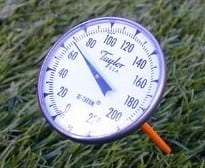 One of the most neglected tools for vegetable gardeners is a soil thermometer. Soil temperature is a much better measure of when to plant than air temperature or the calendar. Planting when soil is too cool can cause some seeds to rot and transplants to not root successfully.
One of the most neglected tools for vegetable gardeners is a soil thermometer. Soil temperature is a much better measure of when to plant than air temperature or the calendar. Planting when soil is too cool can cause some seeds to rot and transplants to not root successfully.
A number of vegetables can germinate and grow at cool temperatures. For example, peas will germinate and grow well at a soil temperature of 40 F. Though lettuce, parsnips, and spinach can sprout at a soil temperature of 35 F, they prefer at least 45 F for best germination and growth. Radishes also do well at a soil temperature of 45 F. Even if the seeds of these cool- season crops are planted below the recommended soil temperature, the seed will rarely rot.
Warm-season crops such as tomatoes, sweet corn and beans are different. They prefer at least 55 F for germination (or transplanting), but others such as peppers, cucumbers, melons and sweet potatoes need it even warmer, about 60 F. If planted when soils are too cool, they likely will rot before germinating.
To take the temperature of your soil first, use a metal soil thermometer, which is sold in many garden, auto parts and hardware stores. Take temperature 2.5 inches deep at about 10 to 11 a.m. Temperature variations throughout the day and night affect soil temperature, with lowest readings after dawn and warmest around mid-afternoon. The late-morning reading gives a good average temperature. Be sure to get a consistent reading for four to five days in a row before planting, and make sure a cold snap is not predicted.
By: Cassie Homan
